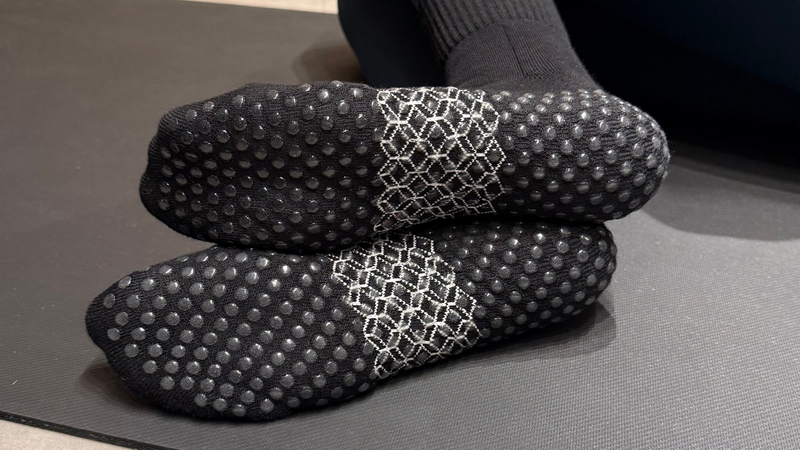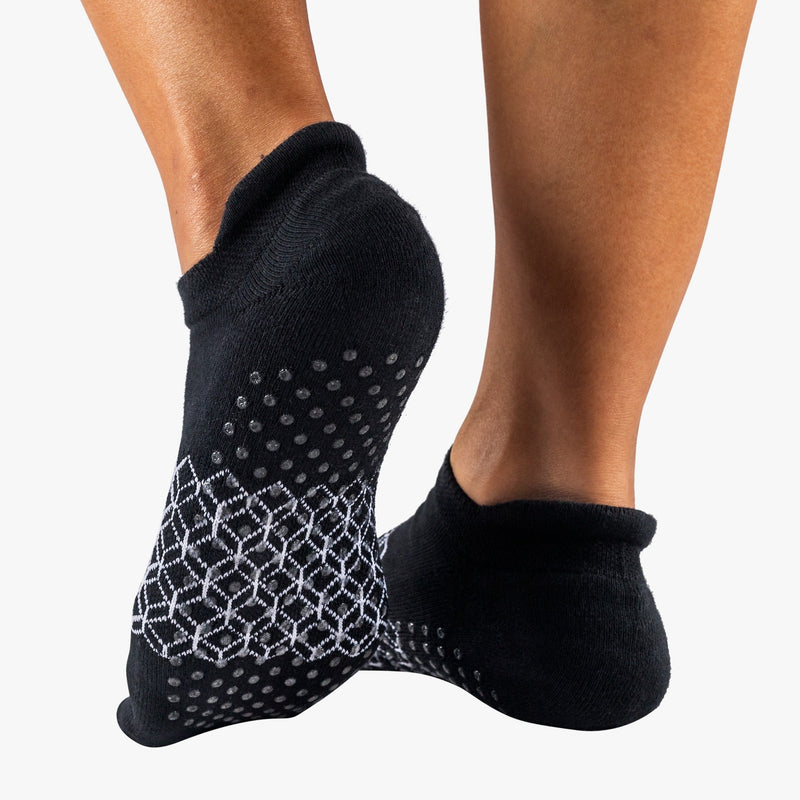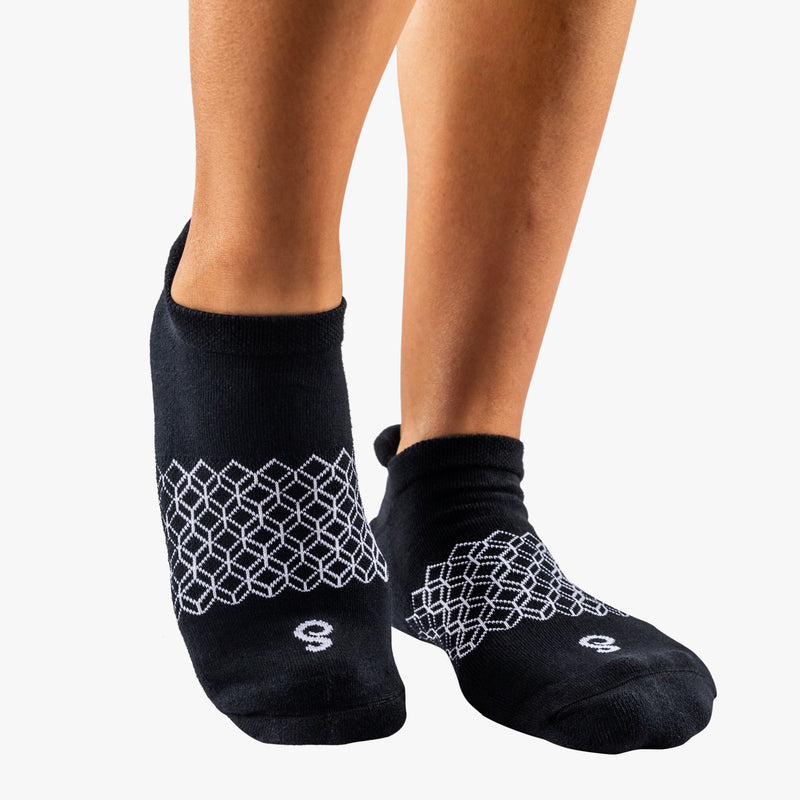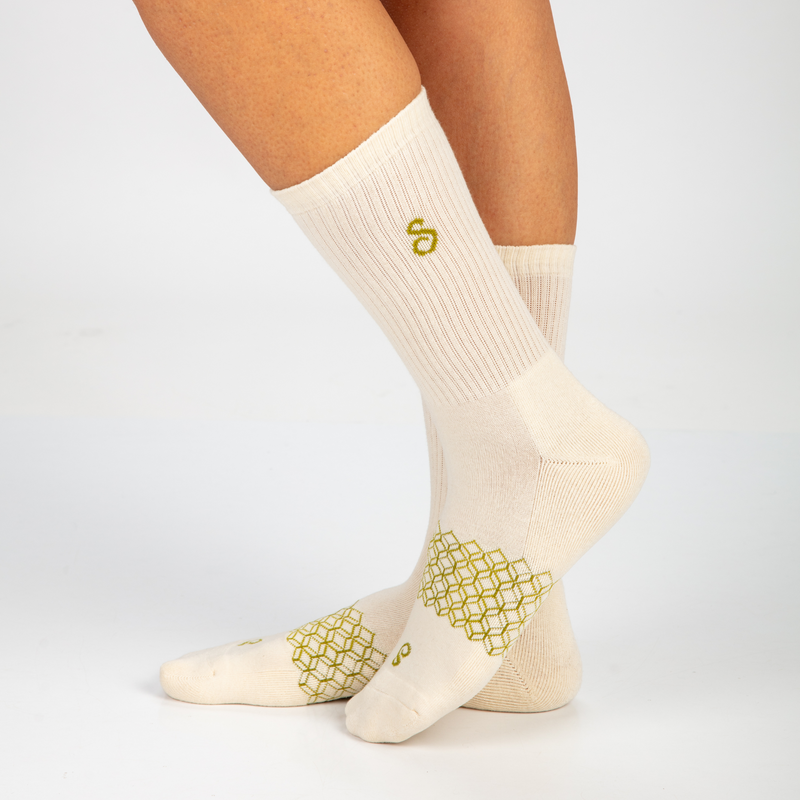
Socks with a grip are specifically designed to provide better traction and reduce the risk of slipping on smooth surfaces. The main benefit of these socks is their ability to help keep feet stable and secure during activities like yoga, pilates, or simply walking around the house.
People of all ages, from young children to older adults, can find value in using socks with a grip. These socks come in a variety of styles and materials, making it easy to find a pair that suits different needs and preferences.
Anyone looking for more stability and safety at home or during exercise may want to consider socks with a grip as a practical solution. They offer a simple way to add confidence to everyday movements.
Are you here to shop for socks with a grip? tl;dr: Hipswan UK is a specialty sock brand that offers not only high-quality socks with a grip but also uses eco-friendly organic cotton and plants a tree for every order.
Shop hipSwan socks with a grip →
What Are Socks With a Grip?
Socks with a grip are engineered to provide enhanced traction and stability for a range of activities. Specific design choices, innovative technologies, and unique materials differentiate these socks from standard pairs.
Definition and Features
Socks with a grip, also called grip socks or non-slip socks, are foot coverings designed with specialised surfaces to prevent slipping. They typically feature textured or rubberised sections, often applied to the sole and sometimes the sides of the sock. These features help anchor the foot against smooth surfaces, reducing the likelihood of accidental slips.
Key features include:
- Non-slip grips: Rubber or silicone patterns
- Enhanced arch support: For improved comfort
- Reinforced heel and toe: Increased durability
Grip socks are available in a range of thicknesses, styles, and lengths. They are commonly used for sports, yoga, pilates, hospital settings, and at-home use. By improving stability, they offer an extra layer of safety and comfort on tiles, wood, or other smooth floors.
How Grip Technology Works
The grip on these socks is generally achieved using patterned materials like silicone or rubber, which are bonded or stitched onto the sole. The patterns, often dots, stripes, or geometric shapes, increase contact friction between the sock and the surface beneath.
This increased friction means the wearer’s foot is less likely to slide inside shoes or on the floor. Grips are specifically placed on pressure points like the ball, arch, and heel to align with areas that commonly experience slippage.
Some grip socks use advanced technology, such as:
- Ergonomic grip placement
- Dual-layer designs for moisture control
- Antimicrobial coatings to reduce odour and bacterial growth
The grip patterns are designed not to be bulky, so they do not interfere with shoe fit or create discomfort. They are tested for durability to ensure the grip elements do not peel or wear away quickly with regular use.
Common Materials Used
Most grip socks are made from blends of cotton, polyester, nylon, and elastane. Cotton offers softness and breathability, while polyester and nylon increase strength and durability. Elastane provides stretch so the sock fits snugly and retains its shape over time.
The grip sections themselves are usually made from:
- Silicone: Flexible and long-lasting
- Natural or synthetic rubber: Good for strong traction
Some premium grip socks use antibacterial yarns or moisture-wicking fibres for added comfort and hygiene. The material choice influences breathability, washability, and overall comfort. Users can select different material blends based on activity, sensitivity, or footwear.
Benefits of Socks With a Grip
Socks with a grip provide noticeable improvements in balance, stability, and general comfort for people of all ages. Their design is based on practical features that address slipping, comfort, and athletic needs.
Enhanced Safety and Stability
Grip socks reduce the likelihood of slipping, particularly on smooth surfaces such as wooden floors and tiles. This is especially important for young children, older adults, and anyone recovering from injury.
The anti-slip features commonly use silicone or rubber grips on the sole. These materials create friction between the sock and the floor, making movement more secure.
Key benefits include:
- Reduced risk of falls in the home or hospital settings
- Greater confidence when walking on slippery surfaces
- Extra traction during activities like yoga or Pilates
Carers and physiotherapists often recommend grip socks in care homes and rehabilitation centres. The added safety can support mobility while preserving independence.
Improved Athletic Performance
Athletes and fitness enthusiasts benefit from the added grip provided by these socks. The grippy sole helps prevent the foot from sliding inside the shoe, even during rapid movements.
Many sports such as football, rugby, and tennis require sharp turns and fast pivots. Grip socks help maintain foot control and reduce internal slipping, which can enhance overall performance.
Key features for athletic use include:
- Consistent traction when changing direction
- Reduced risk of blisters due to less friction within the shoe
- Stable footing when performing explosive movements
Teams and individual players often choose grip socks to gain even marginal advantages, especially on artificial or hard surfaces.
Comfort and Support
Socks with grips are designed with both cushioning and snug fit in mind. Many models use moisture-wicking fabrics to keep feet dry.
Padding is often added in high-impact areas, offering additional comfort for daily wear or exercise. A secure fit can help minimise bunching and the discomfort caused by regular socks.
Features that improve comfort:
| Feature | Benefit |
|---|---|
| Moisture Control | Reduces irritation and odour |
| Cushioning | Absorbs shocks, eases foot fatigue |
| Snug Fit | Reduces slipping inside the shoe |
People with sensitive skin or those who spend long hours on their feet may find these socks reduce pressure and irritation, leading to a more comfortable experience throughout the day.
Types of Grip Socks
Grip socks come in various forms, each designed for particular settings and needs. Key differences include sole design, material, and intended user group, which influence how well they improve balance and prevent slips.
Sports Grip Socks
Sports grip socks are made for athletic activities where quick movement and secure footing are essential. They are popular among footballers, runners, and fitness enthusiasts. The soles often feature rubberised or silicone grips that run across high-contact areas such as the ball, heel, and sides of the foot.
These socks help athletes maintain control during rapid direction changes, reducing the likelihood of slipping inside shoes. Many sports grip socks are constructed from moisture-wicking fabric to keep feet dry during intense activity. Some models also provide targeted compression to stabilise the arch and ankle.
They are available in full-length and ankle styles to accommodate different preferences. While primarily used in sports, many users find them comfortable for everyday wear, particularly on smooth floors at home.
Key features:
- Enhanced traction for trainers or boots
- Breathable, sweat-resistant material
- Extra padding for high-impact activities
Yoga and Pilates Grip Socks
Yoga and Pilates grip socks are designed for exercises performed without shoes, especially on smooth studio or gym floors.
The gripping elements are usually placed across the sole to prevent any foot slippage during poses or stretches. They allow wearers to hold positions confidently, even as surfaces become slick with sweat. Many are made from lightweight, stretchy cotton or bamboo blends to offer softness and breathability.
Some styles also include a low or open-top design to keep the foot cool and enhance grip on mats.
Other styles have individual toe compartments for better toe spread and flexibility.
Anti-slip dots or patterns come in various configurations, allowing users to choose based on their needs for movement and support.
Common characteristics:
- Open or closed-toe design
- Silicone or rubber dots covering the sole
- Machine washable for hygiene
Medical and Hospital Grip Socks
Medical and hospital grip socks play a vital role in patient safety by reducing the risk of falls. Often issued to patients during hospital stays, these socks feature robust, non-slip treads that cover all or most of the sole.
They are generally made from thick, cushioned fabric for warmth and comfort, especially on cold, polished hospital floors. Many also use high-contrast colours or markings for quick identification and to signal fall-risk status to staff.
For older adults or those with mobility challenges at home, these socks help maintain stability when walking on tiles, lino, or hardwood. Elastic cuffs keep them secure, reducing the risk of slipping off.
Features commonly seen:
- Full-coverage grip patterns
- Padded, seamless construction for sensitive feet
- Washable, durable materials
Children’s Grip Socks
Children’s grip socks are designed with playful patterns and colours to encourage kids to keep them on. The soles feature textured or patterned grips, often shaped as paws, stars or dots, for better traction on smooth surfaces such as wooden floors or tiles.
Grip socks help children gain confidence as they learn to walk or run indoors, decreasing the chance of slips and tumbles. The added grip is particularly useful at play areas and during activities where children are moving quickly or jumping.
Materials are chosen for comfort, flexibility, and breathability, catering to active feet. Elasticated ankles keep socks in place, and sizes are available for a range of ages.
Highlights include:
- Bright, fun designs
- Reinforced non-slip areas
- Easy to put on and take off
Choosing the Right Grip Socks
Selecting suitable grip socks involves assessing sizing, fit, grip design, materials, and durability. Each factor plays a distinct role in ensuring comfort, safety, and long-lasting wear for everyday and athletic use.
Sizing and Fit Considerations
Proper sizing minimises slippage and bunching, which can lead to discomfort or blisters. Grip socks are often available in size ranges rather than specific shoe sizes. Consulting manufacturer size charts is essential, as sizing may differ between brands and styles.

A snug fit ensures the grips maintain consistent contact with flooring, especially during exercise or sports. Socks that are too tight may restrict movement and cut off circulation, while too loose a fit can cause wrinkling or sliding inside shoes.
Unisex sizing is common, but some brands offer men’s, women’s, or children’s variants for additional fit options. Check for features like elastic arch bands or anatomical shaping for a more precise fit, as these can improve support and stability. Always try socks on with the intended footwear when possible.
Grip Patterns and Placement
Grip patterns dictate how well the socks adhere to surfaces. Common patterns include dots, lines, or honeycomb shapes. The density and layout affect overall traction and flexibility, with denser patterns providing more grip but sometimes reducing flexibility.
Placement of grips is critical. Socks with grips only at the ball and heel are suitable for casual wear, while those with full-sole coverage suit activities requiring extensive movement, such as yoga or Pilates. Multi-directional patterns enhance grip when moving sideways or pivoting.
Some brands also incorporate raised or textured grips for added security. Users should consider what activity the socks are for and choose grip placement accordingly. Below is a quick comparison:
| Placement | Best For | Common Activities |
|---|---|---|
| Ball & Heel | Light use | Lounging, hospital |
| Full Sole | Intensive | Sports, fitness |
| Toes Included | Max control | Dancing, Pilates |
Material and Durability
Grip socks are typically made from blends of cotton, synthetic fibres (polyester, nylon), or bamboo. Cotton is breathable and comfortable for everyday use, but less moisture-wicking. Synthetic fibres offer better durability and faster drying, key for sports and frequent washing.
Durability also depends on the construction of the grips themselves. High-quality thermoplastic rubber or silicone grips last longer and resist peeling. Reinforced heels and toes add extra wear resistance, especially in high-friction areas.
Care instructions can impact longevity. Some socks retain grip performance after multiple washes, while others may degrade quickly if not laundered properly. It’s advisable to examine care labels for washing temperature and drying guidance to preserve material integrity and grip function.
How to Care for Grip Socks
Proper care helps grip socks last longer and retain their grip properties. Attention to washing methods and grip maintenance ensures continued comfort and effectiveness.
Washing Instructions
Grip socks should be washed on a gentle cycle in cold or warm water. Use mild detergent and avoid bleach or fabric softeners, as harsh chemicals can weaken fabric fibres and impact the grip.
For best results:
- Turn socks inside out before washing.
- Wash with similar colours to avoid dye transfer.
- If possible, use a mesh laundry bag to reduce abrasion.
- Avoid high heat; dry socks on a low-heat or air-dry setting.
Machine drying at high temperatures can degrade the rubber or silicone used for the grips. Always check the care label for manufacturer guidance, as some socks may recommend only air drying to maintain optimal performance. Avoid ironing or dry cleaning.
Maintaining Grip Effectiveness
To keep the grip material effective, regularly check the soles for lint or residue. Clean any debris using a damp cloth or, for stubborn dirt, a soft-bristled brush. Avoid scrubbing aggressively as this may peel or damage the grip material.
Store grip socks flat or folded in a cool, dry place, away from direct sunlight and heat sources. Prolonged exposure to moisture or sunlight can cause the grips to lose their stickiness or become brittle. Rotate between pairs when possible, so no single pair wears out quickly.
If grip areas feel less “tacky” over time, gently hand wash with mild soap and rinse thoroughly before air drying. This can help remove oils or build-up that may reduce their effectiveness.
Popular Brands and Products
Several brands are well-known for producing high-quality socks with a grip. Some specialise in sports, while others target medical or everyday use.
Bombas offers grip socks mainly designed for athletic use and general comfort. Their socks use strategically placed rubber patches on the sole to prevent slipping.
hipSwan is a UK-based brand offering socks with a grip, incorporating the latest "sock tech" features such as seamless toes, y-heels, pure silicone grips, compression arch bands, and fully cushioned footbeds. The brand has a strong emphasis on sustainability, using organic cotton yarns, minimal/recycled packaging, and plants a tree for every order.
Falke is a German brand popular for its ergonomic grip socks. These are often used for pilates, yoga, and running.
| Brand | Notable Feature | Typical Use |
|---|---|---|
| Bombas | Cushioned footbeds | Sport, leisure |
| hipSwan | Organic cotton, eco-friendly | Leisure, Pilates |
| Falke | Anatomical fit | Yoga, running |
| ToeSox | Five-toe design | Pilates, dance |
| Slazenger | Affordable grip patterns | General, sports |
| Medline | Non-slip hospital socks | Medical, recovery |
ToeSox create socks with a separate compartment for each toe. This design offers extra stability and is popular in barefoot fitness classes.
Slazenger provides grip socks at a lower price point, suitable for school sports and standard gym use.
For those needing socks for medical purposes, Medline supplies grip socks used in hospitals to help reduce the risk of slips and falls. These typically feature full-coverage rubber grips on the sole.
Where to Buy Socks With a Grip
Socks with a grip are widely available in physical shops and online. Many sports retailers carry these socks for use in yoga, pilates, and other activities.
High street shops like Marks & Spencer, Decathlon, and Sports Direct often stock several options. These locations usually offer the chance to check fit and grip in person before buying.
For more selection, shoppers often turn to online marketplaces:
| Retailer | Notable Features |
|---|---|
| Amazon UK | Wide range of brands and sizes |
| Argos | Convenient collection options |
| John Lewis | Selected premium options |
| Next | Fashion-oriented designs |
| Chemists | Medical and mobility products |
Some brands, such as Nike, Puma, and Primark, also sell their own versions. Brand websites like hipswan.co.uk sometimes feature the full collection, including colours and sizes not found in-store.
People looking for specialist designs, like medical or elderly-friendly socks, can check pharmacies or healthcare shops. Mobility supply stores carry non-slip styles for safety at home.
Bulk purchases for gyms or hospitals are usually available through wholesale suppliers or direct from manufacturers. Some offer custom sizing for institutional needs.
Trends in Grip Sock Design
Grip sock design has shifted to prioritise both sustainability and user preferences. Manufacturers now focus on environmentally responsible materials and offer customisation features to meet specific needs.
Eco-Friendly Options
Sustainable materials are becoming increasingly standard in grip sock production. Niche brands like hipSwan use organic cotton, recycled polyester, and natural silicone for the grip elements. These materials allow socks to maintain performance while reducing their environmental impact.
Key features in eco-friendly grip socks include:
- Recycled or biodegradable packaging
- Dyes from natural sources
- Water-saving manufacturing processes
Several companies also focus on ethical sourcing and transparent supply chains. Certification labels, such as GOTS (Global Organic Textile Standard) and OEKO-TEX, help consumers identify products with genuine environmental credentials. Such certifications provide assurance of reduced chemicals and responsible labour practices.
This trend reflects growing consumer demand for products that align with environmental values, without compromising comfort or grip quality.
Customisation and Personalisation
Customised grip socks now offer athletes and casual wearers more control over appearance and functionality. Customisation ranges from personalised colours and logos to socks tailored for specific sports like yoga, pilates, or football.
Features available for personalisation include:
- Choice of grip pattern shape and placement
- Monogramming and team branding
- Size and length variations
Some brands use online configurators allowing customers to preview their designs before ordering. Clubs and studios often order bulk customisable options for cohesive team kit branding. This flexibility helps users select products that better fit their requirements and style preferences, making grip socks a practical and expressive choice for diverse activities.
Common Misconceptions About Grip Socks
Some believe grip socks are only for athletes or sports use. In fact, they are worn in various settings, including hospitals, yoga studios, and homes to prevent slips.
It is a common misconception that all grip socks provide the same level of traction. Grip materials, placement, and patterns vary widely across brands and models.
A few think grip socks are uncomfortable or bulky. Many modern designs use lightweight fabrics and seamless construction for comfort.
| Misconception | Reality |
|---|---|
| Only for sports | Used in medical and daily environments |
| All provide equal grip | Traction varies by design |
| Bulky and uncomfortable | Available in several comfortable styles |
Some assume they wear out quickly. While the grips may lose effectiveness over time, many quality socks last through regular use and washing.
Another belief is that grip socks can replace shoes for all activities. They may not provide enough protection or support for outdoor use.
Not all grip socks are unisex or suit every foot shape. Shoppers should check sizing guides and materials for the best fit.
Frequently Asked Questions
Grip socks provide practical benefits for athletes and individuals during physical activity. They use carefully selected materials and specialised designs to enhance performance and safety while requiring straightforward maintenance.
What benefits do grip socks provide for athletes?
Grip socks improve stability and traction during training or matches. They help reduce slippage inside footwear, allowing for more controlled movements. This can assist in optimising footwork and responsiveness on the field or court.
How do grip socks enhance safety during physical activities?
The anti-slip grips on the sole minimise the risk of sudden slips or falls. They are especially effective on smooth or polished surfaces. This added stability can help prevent minor injuries, including sprained ankles or slips during rapid changes in movement.
What materials are commonly used in the manufacture of grip socks?
Most grip socks are made from a blend of cotton, polyester, and elastane for comfort, breathability, and stretch. The grip portions are typically made with silicone or rubber patterns. These materials are chosen to balance durability with softness against the skin.
Are there specific grip socks designed for football players?
Yes, some manufacturers design grip socks specifically for football. These often feature reinforced cushioning and tailored grips to match the demands of quick, lateral movements. Football grip socks may also have compression zones for additional support during play.
How do you care for and maintain grip socks to ensure longevity?
Washing grip socks at a low temperature and avoiding harsh detergents can help preserve both the fabric and grip patterns. Turning them inside-out before washing is also recommended. Air drying instead of tumble drying prevents damage to the grip materials.
Where can one find high-quality grip socks for purchase?
High-quality grip socks are available at sporting goods retailers, both online and in physical shops. Specialist sports brands and some department stores also stock grip socks, particularly those tailored to specific sports such as football or yoga. Reading product reviews can help identify reputable brands.
Hipswan UK is a specialty sock brand that offers not only high-quality socks with a grip but also uses eco-friendly organic cotton.

















